
Street scene in Dotonbori with neon signs reflecting in the canal.
I've lived in Osaka long enough to roll my eyes at most tourist recommendations. The same tired list gets recycled everywhere: Osaka Castle, Universal Studios Japan, Dotonbori.
After years of avoiding these supposedly obvious Osaka attractions, I decided to revisit them with fresh eyes.
Some surprised me. Others confirmed my skepticism. All taught me something about this bustling city I thought I knew completely.
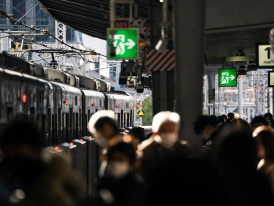
Osaka Station busy concourse with commuters during rush hour. Photo by Satoshi Hirayama on pexels
What Makes Osaka Different from Tokyo?
Most visitors to Japan start with Tokyo or end with Kyoto. Osaka sits between them geographically and culturally. It's less formal than Japan's capital city and more urban than the ancient temples of its neighbor.
This positioning creates something unique: a city that hasn't lost its sense of humor.
Walking through central Osaka, you'll notice the difference immediately. People talk louder here. The comedy clubs aren't just entertainment venues; they're cultural institutions.
This is Japan with its tie loosened, and it shows in every attraction worth visiting.

Train coming into Osakajokoen Station. Photo by Peter Thomas on Unsplash
Osaka Castle: Beyond the Tourist Trap Label
Let me start with the big one. Osaka Castle gets dismissed as a concrete reconstruction, and technically, that's accurate. The current structure dates to 1931, not 1583. But dismissing it entirely misses the point.
Why The Castle Actually Matters
The castle grounds tell Osaka's story better than any museum. I've walked these paths hundreds of times, and the seasonal changes reveal different chapters. During cherry blossom season, the crowds make sense; the 4,000 sakura trees create a pink canopy that transforms the entire area.
The castle itself houses a surprisingly good museum that traces Japanese history through Osaka's evolution from ancient settlement to modern metropolis. The observation deck provides sweeping views over central Osaka, showing how the city radiates outward from this historic center.
Key stops within the castle grounds:
- Main keeps observation deck for city panoramas
- Hokokusha Shrine dedicated to Toyotomi Hideyoshi
- Original stone foundations from the 16th century
- Sakuramon Gate, one of the few authentic structures
Getting to The Castle Without the Crowds
Most visitors approach from Osaka Station via the JR Loop Line to Osakajokoen Station. That's exactly why it's crowded. Instead, take the subway to Tanimachi 4-chome Station. It's a short walk through a residential neighborhood that shows you regular local life before delivering you to the castle's quieter eastern entrance.
The castle grounds also house a traditional tea house where you can experience a proper tea ceremony. It's one of the few places in central Osaka where this aspect of Japanese culture remains accessible to curious visitors.
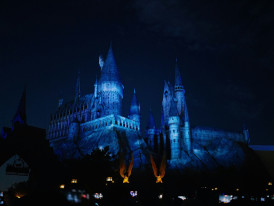
Hogwarts Castle illuminated at night with crowds gathered below.Photo by fan yang on Unsplash
Universal Studios Japan: More Than Just Theme Park Hype
I avoided Universal Studios Japan for years. Theme parks felt too commercial, too removed from authentic Japanese culture.
Then my niece dragged me there for her birthday, and I discovered something unexpected.
The Wizarding World of Harry Potter Changes Everything
Yes, the Harry Potter section is impressive. The attention to detail rivals anything I've seen in Japan, and that's saying something. But what struck me wasn't just the magic; it was watching Japanese families experience something foreign being made familiar.
The wizarding world demonstrates Japan's ability to adopt global culture while maintaining distinct local touches. Even butterbeer is served with unique Japanese hospitality standards.
Beyond Harry Potter at Universal Studios
The park's Japanese-created attractions often outshine the imported ones. There are limited events to look forward to, like the Attack on Titan ride that captured the anime's intensity perfectly.
The seasonal events, particularly the Halloween horror nights, blend Western concepts with Japanese storytelling traditions.
Must-experience attractions:
- The wizarding world for immersive design
- Jurassic Park for classic thrills
- Nintendo World for interactive gaming
- Seasonal events showcasing Japanese creativity
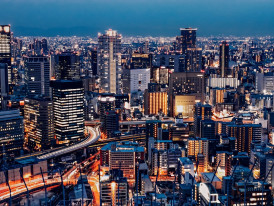
Night view from Umeda Sky Building showing city lights stretching to the horizon.Image by xegxef from Pixabay
Umeda Sky Building: Osaka's Architectural Marvel
The Umeda Sky Building doesn't photograph as dramatically as Osaka Prefecture's castles or buzz as loudly as Universal Studios. But it represents something crucial about this city: Osaka's willingness to take architectural risks.
Why the Sky Building Matters
Completed in 1993, this twin-tower structure connected by a "floating" observatory was considered radical architecture.
Critics called it too bold for conservative Japan. Decades later, it's recognized as an architectural landmark that predicted Osaka's modern skyline.
The observation deck offers 360-degree views, but timing matters. Visit during sunset to watch the city transition from day to night. The neon lights begin flickering on across central Osaka, creating a light show that changes seasonally.
Tucked-Away Spots Inside the Sky Building
Most visitors head straight to the observation deck and miss the building's other attractions. The underground market recreates early 20th-century Osaka streets, complete with vintage storefronts selling traditional snacks and crafts.
The stunning rotating art exhibitions feature local artists exploring Osaka's cultural evolution. For anyone who enjoys art, stopping here is non-negotiable.
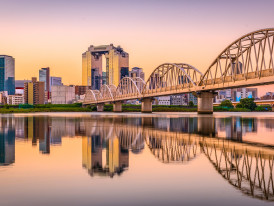
Tempozan Harbor Village with Osaka Bay in background.
Osaka Aquarium: World-Class Marine Experience
The Osaka Aquarium Kaiyukan might be the most underestimated attraction in Osaka. Located on the artificial island of Tempozan in Osaka Bay, it's easy to dismiss as just another aquarium. That would be a mistake.
What Makes Kaiyukan Special
This isn't your typical aquarium. The design follows the Ring of Fire concept, showcasing marine life from the Pacific Rim. The central tank holds 5,400 tons of water and houses whale sharks; the world's largest fish species.
The spiral walkway takes you from the eighth floor down to the first, mimicking a deep-sea dive. Each level reveals different marine environments, from surface waters to deep ocean floors.
Timing Your Aquarium Visit
The aquarium gets crowded on weekends, but weekday mornings offer a different experience. The surrounding Tempozan area includes a Ferris wheel and shopping complex, making it easy to spend a full day trip here.
The harbor views from the Ferris wheel will give you a different perspective on Osaka Bay and the connection to Kansai International Airport across the water.
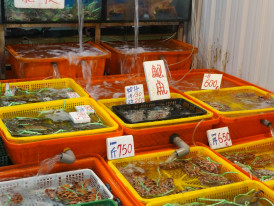
Fresh seafood display at Kuromon Market with price tags in Japanese. Photo by Hailey Tong on Unsplash
Kuromon Ichiba Market: Where Locals Actually Shop
Every city has its famous market, and Osaka's Kuromon Ichiba Market fits that role. Unlike purely tourist markets, this one still serves local residents, creating an authentic blend of commerce and culture.
Navigating Kuromon Like a Local
The market stretches for about 600 meters through Osaka, but not every stall caters to visitors. The ones with handwritten Japanese signs and no English menus? That's where the good stuff lives.
The seafood options change seasonally. Winter brings excellent crab from northern Japan.
Spring features bamboo shoots and mountain vegetables. Summer showcases the bay's catches, including fresh seafood prepared on-site.
What to Eat at Kuromon Market
I recommend you skip the overpriced wagyu skewers aimed at tourists. Instead, try the takoyaki from the stall that's been there for thirty years. The octopus balls here taste different from the Dotonbori versions: less sweet and more focused on the octopus flavor.
Local favorites:
- Fresh seafood sashimi prepared on-site
- Traditional Japanese sweets from established vendors
- Seasonal vegetables and specialty condiments
- Green onions from vendors supplying high-end restaurants
![Vendor preparing fresh takoyaki at a traditional stall in Kuromon Market. ]()

Five-story pagoda at Shitennoji Temple with cherry blossoms in foreground.
Shitennoji Temple: One of Japan's Oldest Temples
Founded in 593 AD, Shitennoji Temple represents some of the earliest history in Osaka.
While Kyoto gets more attention for religious sites, Shitennoji offers something different: a living temple that's evolved with the city around it.
Why This Temple Feels Different
Most of Japan's famous temples exist as historical artifacts. Shitennoji functions as an active religious site serving local communities.
You'll see families praying for success, students seeking academic luck, and elderly locals who've worshipped here for decades.
The temple complex includes multiple buildings representing different Buddhist traditions. The real treasures hide in smaller buildings throughout the grounds.
Exploring Shitennoji's Lesser-Known Areas
The temple's flea market, held on the 21st and 22nd of each month, can give you a glimpse of its community role.
Local vendors sell everything from antique ceramics to handmade crafts, creating monthly celebrations that bring together believers and bargain hunters.
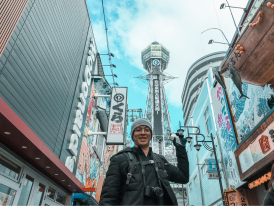
Tsutenkaku Tower rising above the narrow streets of Shinsekai district.
Tsutenkaku Tower: Osaka's Endearing Landmark
Tsutenkaku Tower divides opinions. Built in 1912, destroyed during WWII, and rebuilt in 1956, it's neither architecturally significant nor particularly attractive. Yet it captures something essential about Osaka's character.
Understanding Tsutenkaku's Appeal
This tower represents Osaka's relationship with progress. The surrounding Shinsekai (new world) district preserves an early 20th-century atmosphere. The narrow streets, vintage signs, and unchanged storefronts create a time capsule.
The observation deck offers decent city views, but the real attraction is the neighborhood below. Shinsekai's kushikatsu restaurants serve Osaka's signature fried skewers. The unwritten rule: never double-dip in the shared sauce.
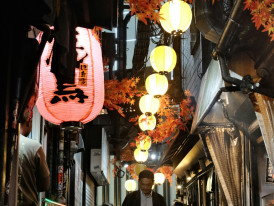
Traditional narrow alley with lanterns and historic restaurant facades.Photo by Perry Merrity II on Unsplash
Namba and Dotonbori: Beyond the Neon Spectacle
Namba Station area and Dotonbori canal represent Osaka in most promotional materials. The neon lights, the crowds, the constant activity; it's visually impressive but can feel overwhelming.
Finding Connections in Tourist Central
Yes, Dotonbori is touristy. But it's touristy because it genuinely represents something about Osaka culture. The exaggerated signs, the street food vendors, the comedy clubs, they're not performing for visitors.
Late at night, after 10 pm, a different character is revealed as locals reclaim the streets. Step away from the main canal to discover narrow alleys that predate the neon spectacle.
Unexplored Corners Near Dotonbori
Hozenji Yokocho alley preserves traditional architecture and hosts restaurants serving the same dishes for generations. The small Namba Yasaka Shrine tucked behind busy streets offers unexpected tranquility with its giant lion head stage.
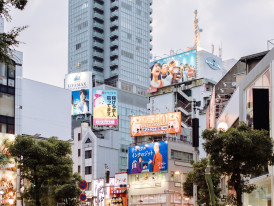
Colorful street art and vintage shop fronts in Amerika-mura district.
Osaka's Shopping Culture: Beyond Consumption
Shopping in Osaka means more than buying goods. It's social activity, entertainment, and cultural understanding. The city's shopping districts each have distinct personalities.
Shinsaibashi: High-End Meets Street Style
Shinsaibashi shopping district stretches along one of Japan's oldest shopping arcade streets. The covered walkway protects shoppers while creating an intimate atmosphere despite crowds.
High-end department stores anchor the area, but side streets reveal independent boutiques and specialty stores catering to specific subcultures. It's where Osaka's fashion-conscious residents shop, not just tourists buying souvenirs.
Amerika-mura: Osaka's Creative Underground
Amerika-mura (American Village) reflects Osaka's creative underground. Vintage clothing stores, record shops, and art galleries occupy buildings housing independent businesses. This area evolved organically as creative businesses found affordable rent in Osaka.
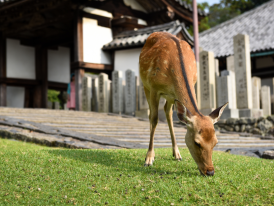
Free-roaming deer in Nara Park with traditional temple buildings in background.
Day Trip Options from Osaka
Osaka's central location makes it excellent for exploring the Kansai region. I think several destinations warrant day trip excursions without requiring overnight stays.
Kyoto: Ancient Capital Within Reach
The train ride to Kyoto takes 45 minutes from Osaka. While Kyoto deserves multiple days, focused day trip visits can provide meaningful experiences. Choose one area rather than trying to see everything.
Also, I recommend that you leave early and return late to avoid peak commuter times. The frequent train stations make spontaneous trips possible.
Nara: Japan's First Capital
Nara offers a completely different pace from Osaka's bustling energy. The deer park surrounding Todaiji Temple creates a pastoral setting, contrasting sharply with urban life.
It's an easy day trip that feels like traveling to different eras.
Kansai International Airport Access
This airport connects directly to Osaka via express trains. The airport serves as a gateway to the region, making Osaka an ideal base for exploring western Japan. Of course, that's only part of the reason why you should come here!
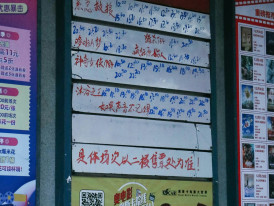
Small family-run restaurant with handwritten menu board outside. Photo by wave wu on Unsplash
Japanese Cuisine Beyond Famous Dishes
Osaka calls itself "Japan's kitchen," and the reputation has merit. The city's food culture extends far beyond takoyaki and okonomiyaki, savory pancakes.
Understanding Osaka's Food Philosophy
"Kuitaore" translates roughly as "eat until you drop." It represents Osaka's approach to food: abundant, flavorful, focused on enjoyment rather than ceremony. This philosophy influences everything from street food to fine dining.
Unlike Tokyo's more formal dining culture or Kyoto's emphasis on tradition, Osaka embraces Japanese cuisine as entertainment.
Meals are louder, messier, more interactive, and just more fun!
Where Locals Actually Eat
The famous food areas serve good food but cater increasingly to visitors. For authentic local dining, venture into residential neighborhoods where restaurants serve regular customers expecting consistent quality.
Local dining areas:
- Sumiyoshi district for family-run establishments
- Tennoji area for working-class food culture
- Side streets near train stations for authentic experiences
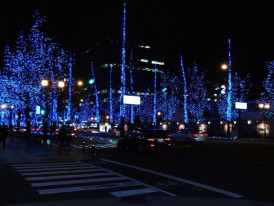
Winter illuminations lighting up Osaka's streets and buildings. photo by Pixabay
Seasonal Considerations for Visiting Osaka
Each season transforms Osaka's attractions differently. Understanding these changes helps optimize visit timing.
Spring: Cherry Blossom Season Management
Cherry blossom season brings crowds but transforms parks and temples. Everywhere cherry trees grow becomes spectacular, but expect company. Arrive early morning or late evening for better experiences.
Summer: Festival Season and Heat
Summer means heat, humidity, and matsuri festivals. The Tenjin Matsuri in July ranks among Japan's greatest festivals. Indoor attractions like the Osaka aquarium provide air-conditioned relief during hot days, giving you another reason to stop there.
Autumn: Comfortable Weather and Colors
Autumn might be Osaka's best season. Comfortable temperatures make walking pleasant. Fall foliage in parks rivals spring's cherry blossoms. Crowds thin after summer's peak tourist season.
Winter: Fewer Crowds and Unique Experiences
Winter tourism drops significantly, creating opportunities for intimate experiences at major attractions. Hot food culture thrives with ramen shops busy all day.
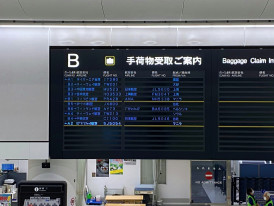
Modern train at Osaka Station platform with digital departure boards. Photo by Suzi Kim on Unsplash
Transportation: Getting Around Efficiently
Osaka's transportation system serves residents first, tourists second. Understanding local patterns helps avoid crowds and delays.
Using Multiple Train Stations Strategically
Osaka Station handles the most traffic, making it consistently crowded. Shin Osaka Station serves the shinkansen but offers fewer local connections. Namba Station provides access to southern attractions and Kansai International Airport.
Each station serves different purposes. Choose your base according to planned activities rather than picking the largest station.
Connecting to Major Attractions
Most Osaka attractions are accessible by train:
- Osaka Castle: Tanimachi 4-chome offers direct access
- Universal Studios: Dedicated themed station
- Osaka Aquarium: Osakako Station to Tempozan area
- Shitennoji Temple: Shitennoji-mae Yuhigaoka Station

Visitors taking photos of Osaka scenery during golden hour.
How Much Time Do You Need?
Planning realistic time allocations prevents rushed experiences and allows for unexpected discoveries.
Half-Day Attractions
The Umeda Sky Building takes 2-3 hours including underground areas. Kuromon Market needs 2-3 hours for leisurely browsing.
Full-Day Attractions
Universal Studios Japan demands full days, especially for multiple themed areas. The Osaka aquarium can fill 4-5 hours when combined with surrounding Tempozan attractions.
Quick Stops
Tsutenkaku Tower and Shinsekai work as 2-hour experiences. Individual temples take 1-2 hours unless attending special ceremonies.
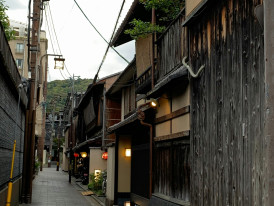
Full-scale recreation of Edo-period street inside the Housing and Living Museum. Photo by Gerard Milecki on Unsplash
Unexpected Delights Off the Beaten Path
Beyond major attractions, Osaka hides smaller treasures rewarding curious exploration. I invite you to find them with a local tour guide that knows the city really well.
Sumiyoshi Taisha: Ancient Shrine Complex
One of Japan's oldest temples, Sumiyoshi Taisha, predates most famous temples in Kyoto. The distinctive architecture uses no nails in construction. Few international visitors make the journey here, but it's easily accessible from central Osaka.
Osaka Museum of Housing and Living
This museum recreates Edo-period Osaka streets in full-scale dioramas. You can walk through reproduced neighborhoods and observe daily life recreations. Interactive elements let you try period clothing and participate in traditional activities.
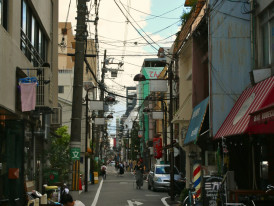
Local residential street with small shops and restaurants near Osaka Castle. Photo by Bruna Santos on Unsplash
Planning Your Osaka Experience
Combining multiple attractions requires strategic thinking about geography, timing, and energy levels.
Geographic Clustering
Osaka attractions cluster together within walking distance, which is why I love walking through the city so much. Osaka Castle, Osaka Station, and Umeda Sky Building form one group. Namba, Dotonbori, and Kuromon Market create another. Universal Studios Japan requires dedicated time.
You should plan full days around these clusters rather than jumping between distant areas.
Mixing Tourist Sites with Local Life
The most satisfying visits combine famous attractions with authentic local experiences. Visit Osaka Castle in morning, then explore nearby residential streets for lunch. This mixing prevents tourist fatigue while providing fun and cultural context.
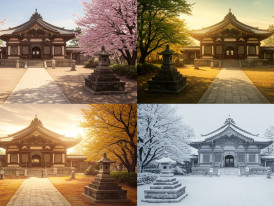
Same temple courtyard in different seasons showing seasonal contrast.
What Makes These Attractions Work?
After revisiting Osaka's major attractions with a fresh perspective, patterns show us what creates lasting impressions.
The Human Element
Major attractions succeed because of human interactions they facilitate. Osaka Castle brings together multiple generations sharing seasonal celebrations. Universal Studios Japan creates common experiences across cultural differences.
Seasonal Transformations
The same attraction offers completely different experiences across seasons. This multiplicity helps appreciate why these sites maintain long-term appeal.
Local Pride and Tourist Skepticism
Talking with local friends about these attractions revealed complex relationships. Many take pride in Osaka's famous spots while acknowledging their commercial aspects.
The best visits balance tourist enthusiasm with local skepticism, appreciating genuine qualities while recognizing manufactured elements.
Making the Most of Your Visit
Successful Osaka exploration requires flexibility balanced with planning.
Timing and Energy Management
Weekday mornings offer the best experiences at popular attractions. Choose 2-3 major sites per day, allowing time for wandering between scheduled activities. The best discoveries often happen during unplanned moments.
Weather Considerations
Osaka's weather significantly impacts outdoor attraction quality. Check forecasts and adjust plans accordingly rather than forcing predetermined schedules.
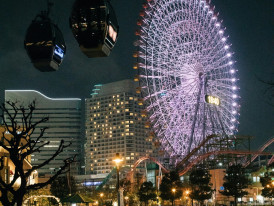
Ferris wheel with city landscape in view. Photo by Tsuyoshi Kozu on Unsplash
Final Thoughts on Osaka's Appeal
Osaka's attractions work because they reflect the city's essential character: unpretentious, enthusiastic, slightly irreverent.
Unlike more formal Japanese cities, Osaka embraces imperfection and celebrates everyday pleasures.
The castle may be a reconstruction, but seasonal celebrations surrounding it are genuine. Universal Studios Japan may be commercial, but creativity and attention to detail reflect authentic Japanese values.
Food markets may cater to tourists, but they proudly serve local communities.
These contradictions don't diminish Osaka's attractions; they define them.
In a country known for perfection and formality, Osaka offers humanity and humor. The city's willingness to be both traditional and modern, serious and playful, tourist-friendly and authentically local creates experiences satisfying multiple needs simultaneously.
Whether you're looking for rich history, contemporary culture, excellent food, or entertainment, Osaka delivers without pretension.
The city doesn't take itself too seriously, and neither should visitors. Approach these attractions with curiosity, appetite, and willingness to be surprised.
After years of skepticism, I've learned that popular attractions often become popular for good reasons. The trick is understanding those reasons rather than simply following crowds.
Osaka's best-known sites have earned their reputations through decades of providing amazing experiences.
They deserve better than dismissive cynicism; they reward thoughtful exploration with genuine insights into this remarkable city's enduring appeal.
For more meaningful Osaka experiences, consider timing your trip during what I like to call the "Osaka best time to visit" for great weather and fewer crowds.

